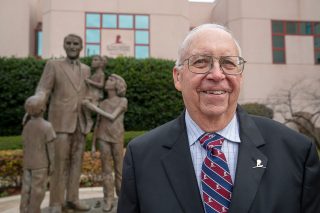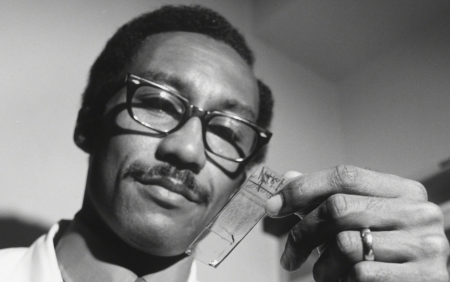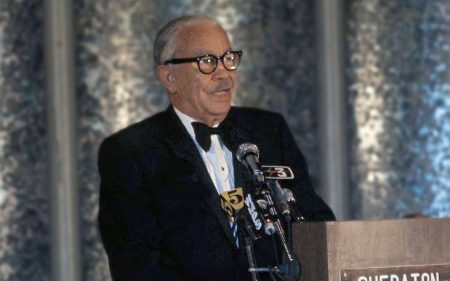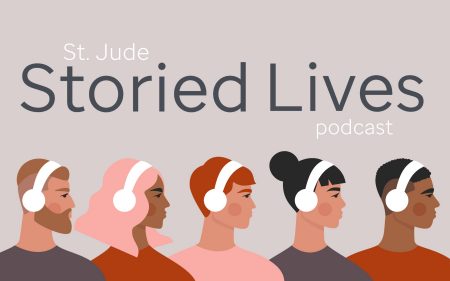
Jack Vosse: Leaving a Legacy for St. Jude
A long-time St. Jude donor, Jack Vosse sheepishly admits he crashed the hospital's opening in 1962. In the years since, he's learned supporting St. Jude requires no special invitation.

May 10, 2019 • 12 min

Jack Vosse is all suited up, which is to say he's wearing a dress shirt customized with St. Jude logo, tie adorned with St. Jude logos and shimmering on his suit jacket, there is a St. Jude lapel pin.
It has been almost two years since Vosse made the drive from Montgomery to Memphis to visit St. Jude Children's Research Hospital, and for the retired Air Force officer and staunch St. Jude supporter, that feels like too long of an absence.
Not that Vosse's heart for St. Jude could grow much fonder.
"I can take any conversation and turn it to St. Jude," Vosse says. "Once I start talking about St. Jude, it's hard to shut me up."
Vosse estimates he's taken perhaps 50 tours over the years, and some who recognize him on this day will recall hearing Vosse tell the story of his first visit to the campus — on Feb. 4, 1962, when St. Jude opened while he was in college in Memphis.
The title of a recent book by a retired St. Jude physician-scientist about this plot of land near the Mississippi River well captures Vosse's own feelings for the place: "On Hallowed Ground."
When he visits, Vosse honors the mission by looking his very best.
On this February morning, almost 57 years to that opening day when Vosse first set foot on campus, the security officer at the front desk discovers what many of Vosse's friends at St. Jude love about him — he doesn't take himself too seriously.
Handing over his driver's license to check in for the day's tour, Vosse quips: "I hate to tell you, but it looks just exactly like me."
Vosse enjoys disarming strangers with the same brand of self-deprecating humor often practiced by Danny Thomas, the late entertainer who founded St. Jude.
Vosse, 78, grew up in the generation who came to know Danny Thomas first as a comedian — and one of America's first beloved TV dads — before his more enduring legacy as the philanthropist who inspired people with his dream of curing children with diseases considered incurable.
Throughout the lobby of ALSAC, the organization Thomas founded to raise funds and awareness for St. Jude, visitors are greeted by quotes about service and devotion.
One from Thomas speaks directly to those like Vosse who have contributed and volunteered: Those who work for the good are as those who do the good.
Inside the offices, there is an enlarged color photo of Thomas unveiling the statue of St. Jude Thaddeus when he opened St. Jude in 1962.
Vosse does not recall what he wore that day nearly six decades ago but does remember that his father, M.J. Vosse, instructed him to stay away from cameras. Although his father was an invited guest to the grand opening, Jack still expresses some sheepishness for showing up without official permission.
"I crashed it," Vosse says. "I can remember my Dad saying, 'You are on your own.' He didn't want to be held responsible for bringing someone who wasn't invited."
As Vosse has come to understand, supporting St. Jude requires no special invitation. Danny Thomas often spoke of rallying an army of compassionate people, and rallies by their very nature attract those who may not have gotten the save the date card.
The story of Vosse's steadfast support of St. Jude reveals a spirit of beckoning, and the enduring lesson of how answering the summons to a noble cause can add greater meaning and purpose to life.
As Vosse tours once again and marvels anew at St. Jude's progress in researching and treating childhood cancer and other deadly diseases, he will find meaning and memory at almost every stop, his awe laced with gratitude for how his own journey has been enriched by the mission of St. Jude.
Statues stir memories
On this sunny February day in Memphis, Vosse walks near the patient care center entrance along the Pathway to Hope, comprised of bricks dedicated to people from every corner of the country.
Alongside, on a small pedestal, is a statue of Danny Thomas, at play with children of St. Jude. Standing before it, Vosse recalls how he and his family first met Thomas, in the years leading up to the opening of St. Jude — when Danny's dream was still a dream.
When Danny Thomas became connected to Memphis' civic, business and medical leaders, it occurred to his father, M.J. Vosse, to offer the pro bono help of his advertising and PR firm.
When the city of Memphis agreed to raise money toward the building of St. Jude, Jack Vosse says, “There was a series of events to raise that commitment, and Dad volunteered his services.”
Vosse recalls meeting Danny Thomas a few times, with the most memorable occasion an event at Memphis' old baseball stadium, Russwood Park, in 1957. For a benefit called "Shower of Stars," Jack and his father chauffeured some of the performers from the Memphis airport to The Peabody hotel.
Among them — movie stars Jane Russell and Susan Hayward.
"I definitely remember when we picked them up," Vosse says. "A limousine company had provided Dad a limo to drive and I would sit in the backseat so I got to sit in between the two of them. One of the things that I remember very well, my Dad saying, 'If you had your driver's license, I would've been in that backseat!'"
Jack remembers how Danny Thomas joined Lou Costello on the stage, set up in centerfield, to perform the famous Abbott & Costello bit, "Who's on first?"
Elvis Presley, then 22, also made an appearance, joining Danny Thomas on stage — although he did not perform.
Just down the Pathway of Hope from the statue of Danny Thomas with the children is perhaps the most photographed spot on the St. Jude campus — the statue of St. Jude Thaddeus. The patron saint of hopeless causes inspired the young Danny Thomas to dedicate any success he might find in life to help the hopeless and helpless.
As he walks, Vosse pauses to read some of the bricks that feature moving tributes to St. Jude patients. He notes that his first experience on the St. Jude campus, at the grand opening, came on a similar sunny February day.
Although it no longer stands on the same spot as when Danny Thomas unveiled it 57 years ago, Vosse describes where he remembers standing on that day he "crashed" the opening celebration.
He would have stood far off to the side, to the left of the statue and Danny Thomas, who was facing the crowd looking west to the river and south to the Downtown skyline.
That view is now obstructed by a highway elevated on the southern border of the campus — Interstate 40, which runs from the Atlantic Coast to California and carries countless travelers past St. Jude.
But everywhere else Vosse looks, he can see the research and care facilities that make this piece of land the epicenter in the world's fight against the catastrophic diseases of childhood.
In 1962, it was but one building, taking up barely more room than the crowd assembled to celebrate the opening. That original St. Jude facility was designed by noted architect Paul Williams in the shape of a star, but Vosse prefers another image.
"I've always thought it looked like a sunrise," Vosse says.
Hearing the words Thomas spoke on that day, and seeing what St. Jude has become, the sunrise metaphor seems apt.
It took a rabble-rousing, hook-nose comedian to get your attention. But it took your hearts and your loving minds and your generous souls to make this fabulous dream come true. I tell you, sincerely, I never thought I would live to see St. Jude Hospital built. Now that it’s done, we have the small task of maintaining it for life and that task falls in particular upon the shoulders of the members of ALSAC and, in general, upon the shoulders of every person who calls himself a citizen of the United States of America.
For Vosse, the specific words Thomas spoke do not linger in his memory nearly so much as the feeling welling inside him — and, he assumes, others who were present.
“I remember asking him that question: ‘Dad, this story is not going to stay in Memphis.’ He says, ‘Well, we all hope not.’”
There is one more Danny Thomas encounter that Vosse has to share. He had graduated college and joined the Air Force, with his first posting at Nellis Air Force Base in Las Vegas, and determined to see Danny Thomas in his popular show at The Sands.
While Thomas entertained the crowd with his vaudeville mix of songs, jokes and storytelling, Vosse asked a waiter to deliver a note to Thomas.
In it, Vosse thanked Danny Thomas for connecting his dream to Memphis, Vosse's hometown, and shared that he had been present for the opening about 18 months earlier.
He did not sign his name, but Thomas paused the show to ask whoever wrote the note please come see him at the stage afterward.
"The stage was raised and he just sat there on the edge of it and we talked for 10 minutes," Vosse said. "He didn't remember me but he remembered my dad. It struck me that even though he had another show that night, he wanted to spend time with me because of that St. Jude connection."
After Danny Thomas died in 1991, he was laid to rest in a crypt behind a Pavilion at St. Jude. Where the St. Jude Thaddeus statue now stands, Vosse can look across and see the Pavilion, which honors the achievements and history of the founder and the hospital.
"If Danny Thomas could see this campus today, how proud would he be?" Vosse says.
Less than 50 yards away, back around the Pathway to Hope, is a spot Jack Vosse makes sure to visit every time he tours St. Jude. It is a garden bench, positioned in an alcove just off the path, and to reach it Jack walks past a large heart which is stamped into the concrete and colored in a variety of small pastel discs.
Contemplating heart, and hope
Across the middle of the heart, in child's script, loops a word that motivates many St. Jude supporters like Vosse: hope.
It is not uncommon to see parents resting on the wooden bench while their child — and sometimes a sibling or two — navigates a mini-maze that weaves through flowers and foliage.
Inscribed on the bench are the words, "Dedicated, With Love, to Lee Vosse."
Lee was Jack's wife.
This is where Jack Vosse stops to tell the part of his St. Jude story that means more to him even than his presence at the opening.
After that encounter with Danny Thomas at The Sands, Jack says he remained an annual contributor to St. Jude, but nearly 50 years passed before he began to engage directly with St. Jude again.
His Air Force career took him to postings in four foreign countries, where he saw firsthand people living in conditions that made him appreciate his own blessings — and follow Danny Thomas' example to help others with whatever he could offer, however modest.
He married Lee, but in their first year of marriage, she was diagnosed with ovarian cancer. After treatments to save her life, she was unable to have children, and though they tried to adopt, it was challenging for people like Jack, in careers requiring frequent out-of-state moves.
The Air Force settled Vosse in Montgomery, Alabama, and then after 25 years of service, Jack transitioned into the private sector as a logistics consultant. Lee, an avid gardener, opened a florist and garden shop.
When she died in January of 2008, at the age of 66, Jack had only recently retired.
In the time that followed, he found himself struggling to find meaning and purpose.
"That's what spurred my rehooking up with St. Jude," Vosse says. "I did absolutely nothing for the first six months after my wife died. Finally, some friends of mine took over and said, 'You've got to stop feeling sorry for yourself. You've got to find something to do.'
"They literally kicked me out of my own house."
As Jack recalls, one day during 2008 he saw a commercial for St. Jude, and shortly after received a piece of mail, which thanked him for his loyal support and asked if he had considered leaving St. Jude in his will.
"Not only had I considered it, but I already had St. Jude in my will," Vosse said. "So I called to let them know."
That led to a call and home visit from a St. Jude philanthropic advisor named Andrew Ellis, to discuss with Vosse how he might deepen his support.
"I've got something now that I've never had before — I've got time," Vosse told Ellis in that initial conversation. "I'd like to do volunteer work for St. Jude if you can tell me how to go about it."
He then heard from Scott Hinshelwood, a former St. Jude patient who helped to coordinate regional fundraising events and initiatives.
"What kind of things do you want to do?" Hinshelwood asked him.
Vosse's reply: "I don't care. I've got time and I want to help. If I can drive there in one day, call me."
Vosse became a regular at St. Jude events throughout the South — Country Cares for St. Jude Kids® radiothons, St. Jude Dream Home® Giveaway events, walks and runs and concerts.
Hinshelwood, who as a patient and fundraiser has come to cherish many supporters, says of Vosse, "In all my time here, Jack is one of my favorite volunteers ever, and the fact that he has that longterm St. Jude history to go with it, makes it so interesting. He's so willing to do whatever — carry a box, answer the phones, or just sit next to a new volunteer and tell them why he loves St. Jude. It goes a long way to keep you motivated to see someone like him who could be doing anything else but helps us out of nothing more than a love for St. Jude."
The legacy of support from the Vosse family had come full circle, from the PR man M.J. Vosse helping with those early events in Memphis to his son, retired Air Force Lt. Col. Jack Vosse, spreading the St. Jude mission throughout the South.
"God sometimes works in strange ways," Vosse says. "I am a person who does not believe in coincidences — I think things happen for a reason. When Andrew came to visit, I thought this would be a wonderful opportunity and fortunately, St. Jude took me seriously."
There is no telling how many times Jack Vosse has reached toward the bronze bust of Danny Thomas and, like so many others who pass through the Danny Thomas Research Center, rubbed the comedian's famous nose — a St. Jude talisman buffed to shiny gold.
Solidarity with Danny's dream
As Ellis, Vosse's St. Jude representative, leads him through the lobby of the pioneering research center, Vosse rubs it once again, wishing not for his own luck but in solidarity with St. Jude patients and families.
Vosse has taken so many tours here that he could recite the pertinent facts himself — that the center was dedicated in 1991 by then First Lady Barbara Bush (who lost her 3-year-old daughter Robin to leukemia in the 1950s), that the center brings together researchers and doctors under the same roof, that the flags from dozens of countries hanging above are representative of the global staff and reach of St. Jude.
His first experience in the Center, Vosse explains, would have come in 2009, after he became actively involved with St. Jude again. A Danny Thomas-St. Jude Society event, for supporters who have left St. Jude in their estate plans, provided him his first-ever tour of St. Jude.
"I was astounded," Vosse said. "Because I hadn't been back to campus since '62. I walked on campus and said, 'Oh my goodness. What is this?'
"To see all that has been done, people from all over who have made it possible to save kids, when 50 years earlier Danny Thomas was told it would be impossible."
He has returned nearly every year since, often for the annual Society gathering in the springtime.
Those foreign flags hanging above remind Vosse of perhaps his most poignant memory of St. Jude: In the summer of 2012, Vosse was among those who gathered at St. Jude for the 50th anniversary celebration.
Ellis was leading a tour, and among those in the small group with them was a girl in her teens, with her family. She was a former patient, a St. Jude survivor from Venezuela.
"It was really a tour she had designed — she wanted to go and see as many of the people she could who had taken care of her while we were here," Vosse said. "I left that tour feeling I had known [her] all my life. Watching the interaction between [her] and the people who hadn't seen her in years, it was like a family reunion."
That night, at the 50th anniversary gala, Danny Thomas' daughter, Marlo Thomas, introduced a former patient to share her St. Jude story.
It was the teen from Vosse's tour.
Vosse still gets choked up thinking about her speech, and especially what happened when she left the stage and saw Vosse at a table with his sister, niece and niece's husband.
"She gave me a great big hug and said, 'Thank you for being a donor,'" Vosse says. "She wasn't just talking about me. She was talking about everybody, to the millions of people who donate to St. Jude."
Before the tour ends, Ellis has a surprise in store. Not far from the Danny Thomas bust, near the doors of the Research Center, two walls feature the names of Danny Thomas-St. Jude Society members like Vosse.
Leaving a legacy
The walls were recently redesigned, because more and more supporters like Vosse have responded to the idea of leaving something for the children of St. Jude.
As original plaques have been removed, St. Jude representatives like Ellis have presented Society members with them, placed in a little pedestal, as a memento of their support.
As Vosse admires the new design, Ellis helps him find, amid the 2009 names, Lee and Jack Vosse, Pike Road, Alabama.
Then Ellis tells Jack he's got something he wants to present him.
"Jack, on behalf of all the children and families of St. Jude you support, I want to present you with a small token of appreciation," Ellis says.
With that, he reaches into his pocket, pulls the small plaque from his coat pocket and hands it Vosse.
"We so appreciate your generosity," Ellis says.
Moved by the moment, Vosse pauses and says simply: "I have loved every minute of it."












